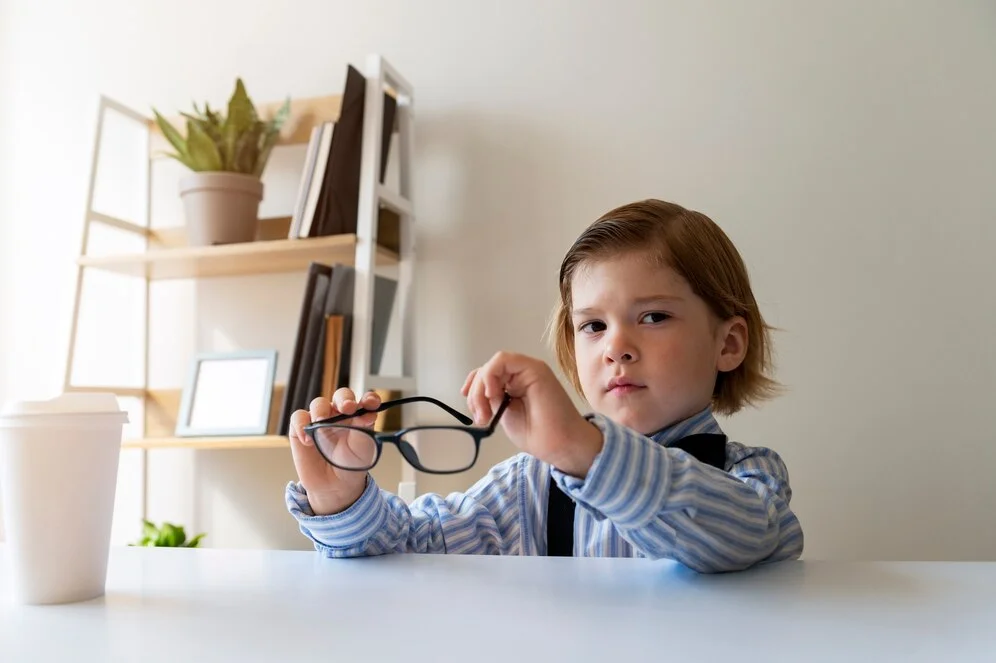Pediatric Eye Myths can delay proper care. Learn the truth and protect your child’s vision with insights from a reputed Eye Surgeon.
Children’s eyes are precious, delicate, and developing rapidly. Yet, many parents unknowingly hold on to pediatric eye myths that can delay proper care and affect long-term vision health. These misconceptions—passed down through family advice, cultural beliefs, or misinformation online—often prevent timely treatment.
By learning the truth behind these myths, parents can make informed decisions that protect their child’s vision for life.
Why Pediatric Eye Health Matters
Children’s vision plays a central role in their growth, learning, and development. Clear sight impacts:
- Academic performance – kids rely on vision for up to 80% of learning.
- Confidence – good eyesight supports social interaction and self-esteem.
- Motor skills – from playing to writing, healthy eyes guide coordination.
- Future independence – early treatment prevents vision loss later in life.
When parents fall for myths, crucial developmental windows may be lost, making some conditions harder to correct.

Common Pediatric Eye Myths Every Parent Should Stop Believing
1. Myth: Children Will “Outgrow” Eye Problems
Many parents believe crossed eyes, lazy eyes, or other childhood eye conditions will resolve naturally.
Reality: Most do not improve without treatment. Early intervention is essential—conditions like amblyopia (lazy eye) respond best before age 7.
2. Myth: Wearing Glasses Weakens the Eyes
Some parents avoid giving their child prescribed glasses, thinking it makes the eyes dependent.
Reality: Glasses don’t weaken eyesight. Instead, they correct focusing problems, allowing proper development. Denying glasses can lead to permanent vision issues.
3. Myth: Screen Time Alone Causes Permanent Eye Damage
With digital exposure rising, parents often blame screens for eye disorders.
Reality: Excessive screen time can cause eye strain, dryness, and headaches but does not cause permanent structural damage. Proper breaks, lighting, and posture help reduce discomfort.
4. Myth: Squinting or Sitting Close to the TV Means Poor Vision
Parents may panic if their child squints or sits too close to screens.
Reality: Sometimes it’s a habit. While it can signal refractive errors, only an eye exam can confirm the cause. Self-diagnosis is unreliable.
5. Myth: Eye Exercises Can Cure All Vision Problems
Some believe simple exercises can correct every eye condition.
Reality: While eye exercises help in certain cases like convergence insufficiency, they cannot fix refractive errors, strabismus, or congenital conditions. Professional care is necessary.
6. Myth: If a Child Passes a School Eye Test, Vision Is Perfect
Parents often rely solely on school screenings.
Reality: School checks are basic and may miss conditions like astigmatism or lazy eye. Comprehensive exams by specialists are essential.

The Science Behind Children’s Eye Care
Childhood vision develops in stages. Early intervention is effective because:
- Neuroplasticity – the brain adapts more easily in early years.
- Preventing long-term damage – untreated conditions may cause irreversible vision loss.
- Growth factor – as the eye grows, correction can stabilize problems early.
Ignoring myths and relying on evidence-based care ensures the best outcomes.
Signs Parents Shouldn’t Ignore
Not every issue is obvious. Watch for:
- Frequent eye rubbing
- Sensitivity to light
- Misalignment of eyes
- Difficulty following objects
- Head tilting while focusing
- Struggling with reading or writing
These subtle signs may indicate deeper problems needing evaluation.
Breaking the Cycle of Pediatric Eye Myths
Why These Myths Persist
- Cultural beliefs
- Outdated advice from relatives
- Misinformation online
- Fear of stigma around glasses
What Parents Can Do Instead
- Educate themselves through reliable sources
- Schedule regular pediatric eye exams
- Encourage open conversations about vision
- Promote healthy visual habits at home
An Eye Surgeon’s Guide to Protecting Your Child’s Vision
When it comes to children’s vision, parents often feel torn between traditional advice and medical guidance. The Best Eye Surgeon in Kolkata emphasizes that relying on professional evaluation rather than myths makes a lifelong difference. With expertise in pediatric ophthalmology and neuro-ophthalmology, specialists like Dr. Tanmoy Biswas provide comprehensive assessments and treatment strategies tailored for children.
This balanced approach ensures that myths don’t stand in the way of early, effective care.

FAQs on Pediatric Eye Myths
Q1. At what age should my child first have an eye exam?
Most experts recommend the first exam at 6 months, again at 3 years, and before school begins, followed by regular check-ups.
Q2. Do children outgrow squint or crossed eyes naturally?
Not always. Many cases require glasses, patching, or corrective procedures. Early evaluation is crucial.
Q3. Can vitamins or diet alone fix eye problems in kids?
While a balanced diet supports overall eye health, structural conditions need medical treatment.
Q4. Are blue light glasses necessary for children?
Not for every child. Limiting screen time and maintaining healthy screen habits are usually more effective.
Q5. Should children wear sunglasses?
Yes, UV protection from an early age helps prevent long-term damage.
Protecting Children’s Eyes Through Knowledge and Care
Pediatric eye health is often surrounded by well-meaning advice, cultural beliefs, and long-standing myths. However, when it comes to protecting a child’s vision, relying on professional guidance rather than assumptions makes all the difference. By debunking common pediatric eye myths, parents can focus on what truly matters—early detection, timely treatment, and consistent care.
Children may not always communicate vision difficulties clearly, and small signs—like frequent blinking, squinting, or holding books too close—can easily be overlooked. This is why regular eye check-ups and evidence-based care are so important. Instead of waiting for issues to “fix themselves” or trusting myths passed down through generations, parents can play an active role in ensuring their child’s healthy visual development.
Good eyesight is not just about reading the blackboard or playing outdoors—it is deeply connected to learning, confidence, and overall growth. Empowering yourself with accurate knowledge and avoiding common misconceptions is the first step toward safeguarding your child’s future.

